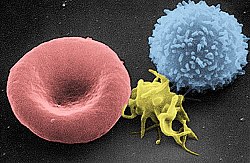Top Qs
Timeline
Chat
Perspective
Pure red cell aplasia
Medical condition From Wikipedia, the free encyclopedia
Remove ads
Pure red cell aplasia (PRCA) or erythroblastopenia refers to a type of aplastic anemia affecting the precursors to red blood cells but usually not to white blood cells. In PRCA, the bone marrow ceases to produce red blood cells. There are multiple etiologies that can cause PRCA. The condition has been first described by Paul Kaznelson in 1922.[1]
Remove ads
Signs and symptoms
Signs and symptoms may include:
- Pale appearance
- Rapid heart rate
- Fatigue
Causes
Causes of PRCA include:
- Autoimmune disease.
- Thymoma.[2]
- Viral infections such as HIV, herpes, parvovirus B19 (Fifth disease),[3] or hepatitis.[citation needed]
- Lymphoproliferative. Association of pure red cell aplasia with T-cell large granular lymphocyte leukemia is well recognized, especially in China.[4]
- Idiopathic. Many cases of PRCA are considered idiopathic in that there is no discernible cause detected.[5]
- Drugs such as mycophenolic acid[6] or erythropoietin.[7][citation needed]
- Congenital. The term "hereditary pure red cell aplasia" has been used to refer to Diamond–Blackfan anemia.[8]
Remove ads
Diagnosis
This section is empty. You can help by adding to it. (February 2024) |
Treatment
PRCA is considered an autoimmune disease as it will respond to immunosuppressant treatment such as cyclosporin in many patients,[9] though this approach is not without risk.[10]
It has also been shown to respond to treatments with rituximab and tacrolimus.[citation needed]
For cases related to B19 parvovirus, administration of commercial immunoglobulin can treat or cure parvovirus by replacing neutralizing antibodies.[11]
Remove ads
See also
- Diamond–Blackfan anemia (genetic red cell aplasia)
- Aplastic anemia (aplasia affecting other bone marrow cells as well)
References
External links
Wikiwand - on
Seamless Wikipedia browsing. On steroids.
Remove ads

